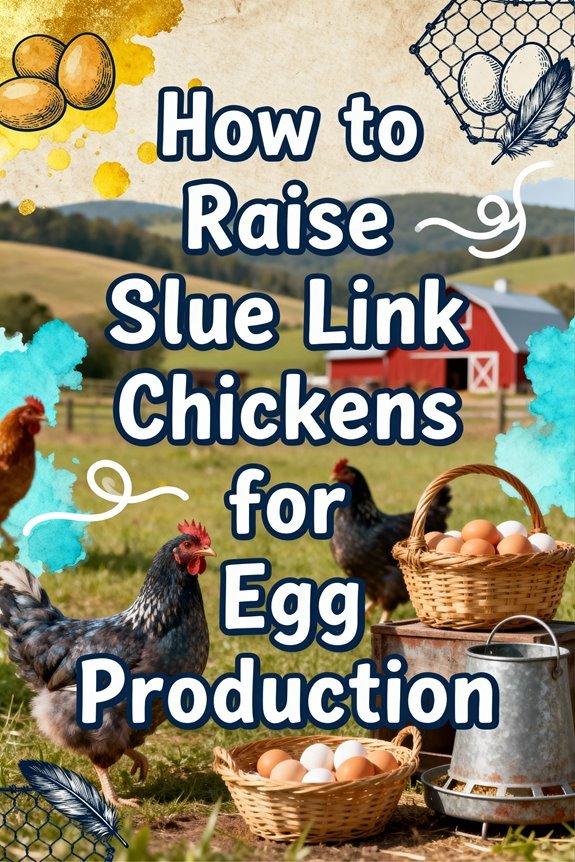Can Chickens Safely Eat Dried Raisins in Their Diet?
You can safely feed dried raisins to your chickens as an occasional treat, but you’ll need to follow specific guidelines. Limit portions to 1-2 tablespoons per bird, ensuring raisins don’t exceed 10% of their daily diet. To prevent choking, soak or chop the raisins before serving, and only use plain, unsalted varieties. While raisins offer nutritional benefits like antioxidants and fiber, proper moderation and preparation techniques are essential for your flock’s health.
The Safety Profile of Raisins for Backyard Chickens
While raisins aren’t inherently toxic to chickens like they are to dogs and cats, their concentrated sugar content requires careful moderation in your flock’s diet. Unlike cases of acute raisin toxicity seen in household pets, chickens process these dried fruits differently through their unique digestive system. Similar to how protein-rich alternatives like cooked eggs and fish are better choices for chickens’ nutrition, treats should be carefully selected. Just as proper feed formulation is crucial for optimal health, treats must be given sparingly.
You’ll need to limit raisin consumption to no more than 10% of your chickens’ total daily intake, typically 1-2 tablespoons per bird. Raisins provide essential nutrients like calcium and iron that support bone health and blood function in chickens. When feeding raisins, you should address potential choking hazards by chopping or soaking them, particularly for smaller breeds and chicks. Store-bought varieties may contain additives that affect chicken digestion, so washing them thoroughly is essential. Monitor your flock for signs of weight gain, reduced egg production, or kidney strain, as these indicate excessive sugar consumption that could compromise their health.
Nutritional Benefits and Drawbacks of Raisins
Although raisins offer valuable nutrients for chickens, their concentrated nature demands careful consideration of both benefits and risks. As a high nutrient density food, they’re packed with antioxidant properties that can support your chickens’ immune system and overall health. The fiber benefits promote digestive health, acting as a natural laxative and supporting gut microbiota. For optimal benefits, consider pairing with nuts when feeding raisins to chickens. Similar to raw green beans, dried raisins should be offered carefully to ensure proper digestion.
You’ll find raisins are an excellent energy source, containing essential minerals like potassium, which helps regulate blood pressure. However, their concentrated sugars, despite a moderate glycemic index, require portion control. While the high caloric content can assist with weight management during active periods, overconsumption may lead to health issues. Like with hydrating cucumbers, offering raisins in moderation is key to maximizing benefits while minimizing potential drawbacks.
Proper Serving Sizes and Feeding Guidelines
Three critical factors determine proper raisin feeding for chickens: portion size, frequency, and preparation method. You’ll need to maintain strict portions control, limiting servings to 10 grams per chicken weekly. Don’t exceed feeding frequency of once or twice per week, as overfeeding can lead to serious health issues like kidney problems and fatty liver syndrome.
Before serving, soak raisins in warm water for 10 minutes to soften them and reduce choking risks. You must guarantee they’re plain, unsalted, and free from additives. Keep raisins to no more than 10% of total dietary calories, maintaining balanced feed as 90% of their diet. If you notice signs of digestive upset or weight gain, reduce or eliminate raisin treats immediately. Raisins are an excellent source of B complex vitamins that help regulate your chickens’ energy levels and metabolism. Even the largest chicken breeds like the Brahma roosters, which can weigh up to 14 pounds, should follow these same portion guidelines to maintain optimal health.
Preparing Raisins to Minimize Health Risks
Proper preparation of raisins stands as an essential safety measure when feeding these treats to your chickens. You’ll need to implement specific soaking techniques to reduce choking hazards and improve digestibility. Place raisins in clean water until they’re soft and plump, which helps prevent crop impaction and dilutes concentrated sugars.
Maintain ideal storage conditions by keeping raisins in airtight containers in cool, dry places before preparation. You’ll want to use only plain, unsweetened varieties and avoid those containing preservatives or sulfur dioxide. Always rinse raisins thoroughly if you’re unsure about chemical treatments. When preparing them, you can chop larger pieces into smaller ones for younger birds, and don’t cook them, as this reduces nutritional value and may cause crop issues. Ensure treats like raisins are limited to once a week to prevent potential health problems from excess sugar consumption.
Signs of Raisin Overconsumption in Chickens
When chickens consume excessive amounts of raisins, they’ll exhibit several distinct warning signs that require immediate attention. Through careful symptom observation, you’ll notice decreased appetite, lethargy, and possible diarrhea as initial indicators. Watch for a reduction in egg production and signs of mild dehydration, which often signal the onset of toxicity. Even foods containing raisins like baked goods and trail mix can trigger these symptoms. Adding fresh oregano leaves to their diet can help support immune function while monitoring for toxicity signs. Rhode Island Reds are particularly susceptible to these symptoms due to their high metabolism and egg production rates.
More severe symptoms include kidney dysfunction, manifesting as excessive thirst or reduced urination. You’ll need to monitor for elevated creatinine and blood urea nitrogen levels, though specific laboratory tests for raisin toxicity aren’t available for chickens. If you observe persistent vomiting, severe lethargy, or neurological symptoms, seek immediate veterinary care. Prompt dietary adjustments are essential upon noticing these signs, as continued raisin consumption can lead to kidney failure and death.
Balancing Raisins With Regular Feed
Successful integration of raisins into your chickens’ diet requires careful attention to portion control and feeding frequency. Keep portions to 1-2 tablespoons per chicken, offered once or twice weekly, and confirm raisins don’t exceed 10% of their total diet. Maintain proper raisin storage in airtight containers to preserve freshness and prevent mold growth. Antioxidants and vitamins in raisins can support immune health and egg production quality. Supplementing with dark leafy greens can further enhance egg yolk quality and overall nutrition.
To enhance dietary variety and safety, mix chopped or soaked raisins with regular feed rather than serving them alone. You’ll need to monitor your flock’s condition closely when introducing these treats, as excess sugar can lead to obesity and metabolic issues. Remember that balanced poultry feed should comprise 90% of their diet, providing essential proteins and nutrients that raisins lack. For ideal health, always prioritize nutritionally complete feed over sweet treats. Adding oyster shells to their diet is essential for proper calcium intake and strong eggshells.
Special Considerations for Young and Small Chickens
Young and small chickens require heightened caution when consuming raisins due to their vulnerable digestive and renal systems. You’ll need to watch for raisin toxicity concerns, as their immature kidneys can’t efficiently process concentrated sugars, potentially leading to organ stress or failure.
To minimize risks, you shouldn’t feed raisins exceeding 10% of their total diet, with even lower amounts recommended for chicks and bantams. When offering raisins, soak or chop them into smaller pieces to prevent choking hazards. You’ll also want to supervise feeding sessions closely. Dried fruits are limited since they contain higher sugar concentrations compared to fresh options.
Consider that young birds need high-protein, low-sugar diets for proper development. While raisins contain beneficial vitamins and minerals, their high sugar content can disrupt digestive balance. These feeding recommendations help guarantee your young chickens’ safety while still allowing controlled treat consumption.
Seasonal Feeding Strategies for Raisin Treats
Adapting your raisin-feeding schedule to seasonal conditions helps optimize your chickens’ health and nutrition throughout the year. During hot summer months, you’ll want to limit raisin treats to prevent metabolic heat stress and digestive issues. Instead, focus on fresh, hydrating alternatives like grapes. Experts recommend maintaining optimal feeding temperatures between 150-180°F when processing poultry feed. Using a treadle feeder system can help regulate portions and prevent waste when offering treats to your flock.
Fall and winter present ideal times for offering raisin treats, as they provide concentrated calories when foraging opportunities decrease. You’ll find these seasonal variations align with your flock’s changing energy needs. Consider weather considerations carefully – moderate temperatures are best for feeding sugar-rich treats like raisins. Excessive consumption can lead to potential kidney failure in chickens, making strict portion control essential.
When planning your seasonal feeding strategy, aim to match raisin availability with storage capabilities and your chickens’ nutritional requirements. Remember to maintain the 10% treat rule regardless of season to guarantee proper dietary balance.
Alternative Treats to Complement Raisin Feeding
While raisins make an excellent treat for chickens, incorporating a diverse selection of alternative treats provides crucial nutritional variety and enrichment opportunities for your flock. You’ll find fresh fruit variety particularly beneficial, with options like strawberries offering vitamins A, C, and B9, while blueberries deliver potent antioxidants. When selecting grain options, consider offering cooked rice or oatmeal as carbohydrate-rich alternatives. Cutting berries into smaller pieces helps create safe serving sizes for your chickens to consume.
Remember that treats should comprise no more than 10% of your chickens’ daily diet to maintain optimal health. For protein supplementation, you can provide mealworms, crickets, or scrambled eggs, especially during molting periods. Don’t overlook vegetable options like kale and ripe tomatoes, which contribute significant nutrients to your chickens’ diet. While chickens serve as disease sentinels in many communities to monitor mosquito-borne viruses, they still benefit from a varied diet. During summer months, frozen watermelon cubes can serve dual purposes as both a treat and a cooling aid, while pumpkin pieces offer both entertainment and natural deworming properties in fall.
Best Practices From Experienced Chicken Keepers
Experienced chicken keepers have developed proven methods for safely incorporating raisins into poultry diets. Through careful observational practices, they’ve found that monitoring individual treat preferences and reactions is essential before establishing regular feeding patterns. You’ll want to introduce raisins gradually and watch for any digestive issues or behavioral changes. Some owners rinse dried fruits to create a rehydrated texture that chickens prefer.
Many keepers strategically reserve raisins for winter months when chickens need additional energy sources. Just like with black oil sunflowers, treats should be offered in moderation as supplements rather than main food sources. You should maintain strict portion control, limiting treats to 1-2 tablespoons per bird, and never exceed 10% of their total diet. While some debate exists about potential renal risks, the consensus supports using raisins as occasional treats rather than dietary staples. You’ll achieve the best results by combining these treats with a properly balanced feed program.


